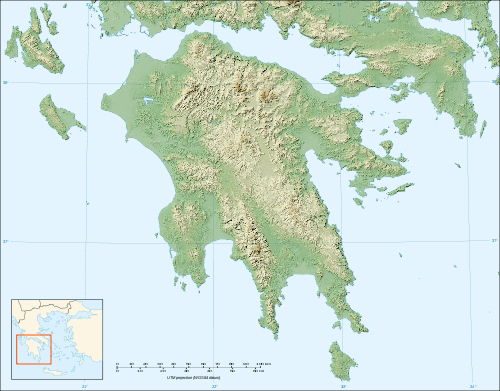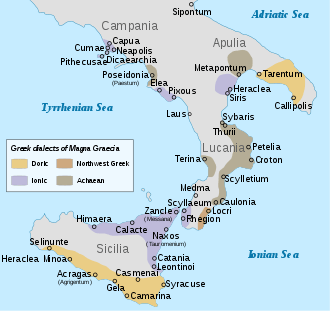Acharnae
Acharnae or Acharnai (/əˈkɑːr.niː/; Ancient Greek: Ἀχαρναί)[1] was a deme of ancient Athens. It was part of the phyle Oineis.[2]
Ἀχαρναί | |
.jpg) A scene from Acharnes, location of the winter palace of the former royal family. | |
 Acharnai Shown within Attica |
Acharnae was according to Thucydides, the largest deme in Athens.[3] In the fourth century BCE, 22 of the 500 members of the Athenian council came from Acharnae, more than from any other deme.[4]
Acharnae was located in the west-northwest part of the Attic plain, 60 stadia north of Athens, south of Mount Parnes. It was from the woods of this mountain that the Acharnians were enabled to carry on that traffic in charcoal for which they were noted among the Athenians.[5][6] Their land was fertile ; their population was rough and warlike; and they furnished at the commencement of the Peloponnesian War 3,000 hoplites, or a tenth of the whole infantry of the republic. They possessed sanctuaries or altars of Apollo Aguieus, of Heracles, of Athena Hygieia, of Athena Hippia, of Dionysus Melpomenus, and of Dionysus Cissus, so called, because the Acharnians said that the ivy first grew in this deme. One of the plays of Aristophanes bears the name of the Acharnians.[7][6]
The Acharnians chiefly grew cereals, grapes, and olives. Acharnae was the centre of the Athenian charcoal-burning industry, and the chorus of Aristophanes' comedy The Acharnians is made up of charcoal-burners.[8] Pindar characterizes them as notably brave. A tholos tomb at Menidi suggests Acharnae was once an independent entity; a temple to Ares was later moved to the Athenian Agora.
The site of Acharnae is located at and southwest of Menidi (renamed to modern Acharnes).[9][10]
See also
References
- Stephanus of Byzantium. Ethnica. s.v.
- Dow, Sterling (1961). "Thucydides and the Number of Acharnian Hoplitai". Transactions and Proceedings of the American Philological Association. 92: 72.
- Thucydides. History of the Peloponnesian War. 2.13, 19-21.
- Dow, Sterling (1961). "Thucydides and the Number of Acharnian Hoplitai". Transactions and Proceedings of the American Philological Association. 92: 70.
- Aristophanes, Ach. 332.
-

- Pausanias. Description of Greece. 1.31.6.
- van Hook, LaRue (1934). "Charcoal in Ancient Greece". The Classical Weekly. 27 (24): 188.
- Lund University. Digital Atlas of the Roman Empire.
- Richard Talbert, ed. (2000). Barrington Atlas of the Greek and Roman World. Princeton University Press. p. 59, and directory notes accompanying.
External links
| Wikimedia Commons has media related to Acharnae. |
- Richard Stillwell, ed. Princeton Encyclopedia of Classical Sites, 1976: C.W.J. Eliot, "Acharnai (Menidi), Attica, Greece"
